Ryan Hall's Blog, page 136
August 28, 2017
She Became A Leadwoman While 18 Weeks Pregnant

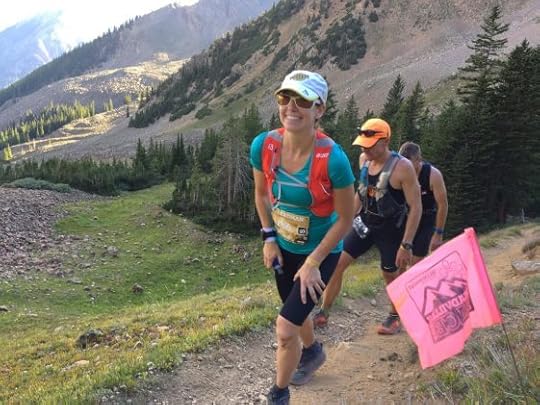
Erin Drasler crossed the finish line of the Leadville Trail 100 in 29:03:45. That accomplishment made the 36-year-old woman a Leadwoman—at 18 weeks pregnant. To become a Leadman and Leadwoman, participants complete five races in the Leadville series—Leadville Trail Marathon, Silver Rush 50 MTB or Run, Leadville Trail 100 MTB, Leadville 10K Run and Leadville Trail 100 Run presented by New Balance—in a single year.
We chatted with Drasler to find out about her training, what it means to be a Leadwoman and what she wishes pregnant woman knew about exercise during pregnancy. (As a note, she laughed when telling us that her first pregnancy took place during her Emergency Medicine residency, which she considers longer and definitely more stressful than the races.)
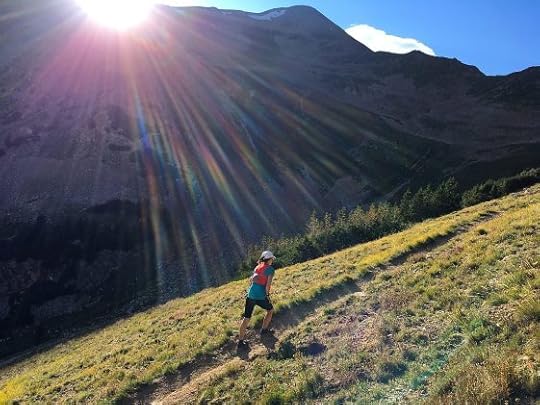
Did you find out you were pregnant during the series?
“No, before the series started, so it was during my training. On the first race of the series I was already nine weeks pregnant and then on the last race of the series I was 18 weeks.”
They say if you’re active you can keep exercising safely, but were you worried about taking this on once you found out?
“The thing that I was most worried about was that a lot of the challenge of the Leadwoman series―and doing 100 miles and endurance racing in general―is that it’s mental; you have to push through walls and that’s what I was most worried about. I wasn’t worried about continuing to be active during pregnancy because I know that it’s safe and I had a pretty high level of activity before I got pregnant. I wasn’t worried about continuing it, but I was worried about pushing through any sort of lulls or pushing myself because I feel that’s where you can get into trouble; I was worried about not having the same mental ability to push through walls that I basically would not have if I was not pregnant. I pretty much thought I might drop out the whole time, especially all the long races. I was like, Well I’ll just see how it goes, but I was not 100 percent convinced that I was going to finish because I felt like I was going to put my baby first.”
Did you have any issues―especially during the first trimester―that impacted how you were out on the course?
“I did. I had some issues with nausea and I had a lot of issues with dizziness and lightheadedness. My blood pressure was really low and I guess fortunately for me I felt better when I was exercising, but it was certainly harder to exercise just with fatigue and everything. It was harder to get the same volume of training. I think my training definitely suffered, which was also a little bit worrisome going into the series. I think that I had as good of a training block as I could have.”
Do you think women shy away from doing these kinds of challenges? Are you hoping to encourage woman to not let pregnancy stop them from doing things like this?
“I feel like when I found out that I was pregnant, I searched on the internet to try to find stories of other women that have done similar things and had good experiences with it. There’s really very minimal out there and I mean, it’s not for everyone. I think one thing that I found is that obviously, you’re heavier and you’re not as fast. I was 12 pounds heavier when I did the Leadville Trail 100. But I think that if you’re not thinking about it as racing then it’s very doable. I don’t think it’s dangerous to the baby and I think that’s one thing that I felt like I struggled with over and over again. When everybody found out that I was still going to do it, they gave me this look like I was insane. People have this perception that you’re going to cause damage to the baby. A lot of conservative guidelines don’t really have any evidence behind them. Just dealing with the conservative stigma that I was getting was really difficult.”
Is there anything you would change or do differently for any of the races that you can think of? Or are you pretty happy with how it all went?
“I’m pretty happy with how it all went. Because I wasn’t feeling that well during first trimester, I sometimes had to pick whether to focus on running or biking; because the run was what I really wanted to finish, the run was sort of my goal and it’s just such an emotional experience. I’ve been up there pacing my husband many times for it, so that’s what I really wanted to finish and I feel like sometimes I focused on that more than the bike. I’m not a particularly good cyclist, so I think that was a big struggle for me, especially since I really didn’t want to fall. I think that I took the downhills far slower than I otherwise would have, but I don’t think I would have done that differently. I just felt like that was what I needed to do.”
RELATED: Michael Wardian Completes 100-Miler and Marathon In One Weekend
The post She Became A Leadwoman While 18 Weeks Pregnant appeared first on Competitor.com.
August 25, 2017
A Trail Runner’s Account Of Running Ireland’s Wicklow Way

Just south of Dublin, Ireland, you’ll find everything imagined of an Irish countryside. The green hills are sprinkled with grazing sheep, lined with stone walls, spotted by lakes, and adorned with stands of bright yellow Gorse bushes. There are valleys home to ancient ruins, standing as stone reminders of past wars, rebellions and exploits. And, of course, the quaint villages and pubs filled with aged whisky, local stouts and ciders, hardy cooking, and warm hearths.
Should you choose to weave this all together in an action-packed adventure, you can run the Wicklow Way, an 83-mile trail that runs between Wicklow and Marlay Park in Dublin. Depending on how much time you are able to take and your desired pace, you can run all or most of the Wicklow Way in a long weekend or, alternatively, you can make a full week of it and add on some side trails and take in some more of the southeastern Irish coastal sights.
As the brainchild of J.B. Malone, born in 1914 in Dublin’s southern suburbs, the Wicklow Way came about through his meticulous notes and regular hikes into the heathery hills that he explored and shared by documenting the history and landscape in various writings. The first complete concept of the trail was published in 1966.
The route allows one to run through history with variety at every turn, covering every surface one could desire, and some that may elicit an expletive or two. The footing types include boardwalks of raised wooden planks covered by chicken wire and U nails, mud, bogs, some road connections, rocks, sandy sections, and grassy tracks over the knolls that afford coastal views of the Irish Sea.
I arrived in Dublin early on April 21 and took an incredibly scenic train journey along the coast to Greystones, where Fred Verdier of Wicklow Country Tourism met me and shuttled us to the start of our run at the Glenmalure Lodge, a beautiful pastoral setting where we met up with runners Paul Daly, Stephen Brennan, and Cindy Doyle. Daly and Brennan then gave us a guided running tour leading the way from Glenmalure to Glendalough, covering some incredible terrain and views that included waterfalls, Lungnaquilla Mountain (one of Ireland’s highest), and, eventually, some lakes that marked the 18K day’s stopping point.
The day was completed with dinner at the Wicklow Heather Restaurant, where we had our first pints of Guinness and were given a tour of the historical prints of famous Irish authors like James Joyce and Bram Stoker.
The next morning we were greeted by a chipper group of Wicklow-area trail runners. The route of the day detoured from the classic Wicklow Way to include Scarr Mountain and Djouce Mountain. The 32K day was clear enough to see the Irish Sea and the Guinness estate, which features a black-watered lake and imported white sands to mimic the look of a Guinness pint.
Exploring the Wicklow Way, I had covered more than 50 very pleasant miles in three days, met some wonderful people and tasted some delicious food and drink that makes this running destination a sport worth exploring.
RELATED: What You Need To Know If You Are Traveling To A Race
The post A Trail Runner’s Account Of Running Ireland’s Wicklow Way appeared first on Competitor.com.
What The Editors Can’t Run Without

These are the running items we absolutely cannot run without. Whether it’s a pair of shorts that make you feel faster or a watch that makes training easier, these are the items that help make us go. See what the editor’s running gear picks are for this month.
RELATED: What Shalane Flanagan Can’t Run Without


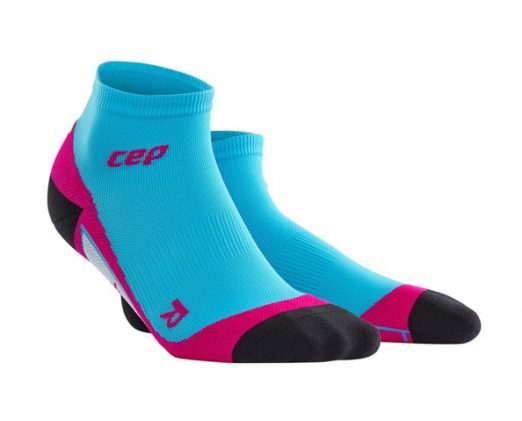



The post What The Editors Can’t Run Without appeared first on Competitor.com.
August 24, 2017
Runners Share The Best—And Worst—Advice They’ve Received

We asked, you responded…what’s the best and worst running advice you’ve ever received?
Best Advice
“Before splashing aid-station water on your face, check that it’s not Powerade.” —Brad Stewart
“Never trust a fart after 2 miles.” —Jeff Vollmer
“Make sure you have a solid base before you start your 16-week marathon training.” —Stacy Bagal

“Run your race, stay your pace!” —Malini Nagpal
“Use lotion! After my first really long run, it wasn’t only advised, it was self-taught.” —Ryan Clifton

Worst Advice
“Store items (fuel, phone, etc.) in my bra. Terrible advice. It’s a great way to ruin a phone and chafe!” —Victoria Erin
“You can just use any shoes. No need to go buy running shoes.” —Mike Brosenne

“My foot strike should be from heel-to-toe.” —Steve Coleman
“Write the date you started wearing new running sneakers on the inside of the tongue with a Sharpie, then you’ll know when to change them. You’ll also end up with a black smudge on every single pair of white running socks you own because when you sweat, the Sharpie smears off!” —Lynn Stroup Latham

“A guy on a race shuttle tells the group around him, ‘Go out fast so you can bank your time!’ I DID NOT do this.” —Kendra Vandenakker Alcock
RELATED: 10 Pieces Of Awesome Advice From Top Runners
The post Runners Share The Best—And Worst—Advice They’ve Received appeared first on Competitor.com.
Strava Wants Athletes To Share Their Unfiltered Post-Workout Photos

The biggest complaint most people have regarding social media is that it’s not real. Social networks are now pushing more visual content through videos and photos. However, this means that the best image we share often isn’t a reflection of our true life. Strava, the social network for athletes, wants to change that perception.
Their new campaign, Athletes Unfiltered, wants to showcase the raw, gritty and not-so-curated experiences that occur while working out. Strava launched the new initiative with a short film starring real-life members of the network. Throughout the video, those athletes share the thoughts and emotions connected to their activities. While not every thought during a run is joyous, Strava wants their network to be free of the negativity found in other places around the internet.
“Strava is a real, raw, very unfiltered social network,” Gareth Nettleton, VP of Marketing said in a press release. “We believe that people all over the world are exhausted by the pressure to always present a perfect, curated self on other social networks. So we wanted to make it very clear that Strava is a place to put it all out there and be yourself. Unity and acceptance—that’s what this campaign is about.”
Strava wants every user to share their sweaty, authentic post-workout photos, both on their website and on other social media networks. Tag your photo with #AthletesUnfiltered to show the world—or at least your closest social contacts—what you accomplished while running.
“I show off me, this is me,” said Harx Kalsi, a London-based runner and Strava member. “I have rubbish runs, I have great runs. Like, this is what happens. This is who I am, and I am sharing that with you, whether you like it or not.”
RELATED: Why Everyone Appears To Be A Better Runner On Social Media
The post Strava Wants Athletes To Share Their Unfiltered Post-Workout Photos appeared first on Competitor.com.
Compression For Runners: Is It Worth It?

Trends come in cycles. One of the trends most popular runners have adopted over the past few years has been compression garments. Manufacturers tout their alleged benefits. They include enhanced blood flow, higher oxygen uptake, increased running performance, faster recovery times and injury prevention.
Highly competitive runners and triathletes who are looking for a competitive edge will pay big money if there is even a hint of a benefit. But what does science reveal about the claims made by manufacturers of compression garments?
Compression Gear Put To The Test
Several scientific studies on compression technology did not conclude there was a meaningful difference between the group with compression and without. A comprehensive study in 2013 specifically tested the claim of increased blood flow with compression shorts. The researcher did not see an increase but rather a decrease in blood flow to the lower extremities. A review of about 30 other studies suggested that the proposed benefits were localized to sports requiring more explosive jumping activities like basketball and certain track and field events.
Yet another study was published in the International Journal of Sports Physiology and Performance. The researchers tested 16 male elite runners and put them through a litany of tests at increasing speeds without compression technology. The researchers tested the group again, this time wearing the compression garments. As previous studies concluded, there was no difference in oxygen uptake, biomechanical efficiency or blood flow among the group.
So Is It Worth It?
Study after study has concluded the same thing. So why do athletes buy compression garments? One of the answers is herd mentality. This describes the tendency for people to be influenced by their peers. As coaches, we constantly try to get runners and triathletes to resist throwing money at their problems. In the never-ending search for a shortcut to training, endurance enthusiasts will buy whatever they see others wearing if they believe it works. Because others have it, they want it too.
The other reason may be the good old-fashioned placebo effect. If you think it works, perhaps it impacts your performance in some way. An old episode of Seinfeld comes to mind. I can just hear George Costanza now. “Jerry just remember, it’s not a lie if you believe it.”
RELATED: 5 Compression Options For Endurance Athletes
The post Compression For Runners: Is It Worth It? appeared first on Competitor.com.
How To Break Out Of Your Running Slump

Getting stuck in a running slump happens to every athlete at least once in their career. It doesn’t matter if your slump is physical or mental. Climbing your way out of a rough patch in training or racing can feel like beating your head against a wall.
I have spent many years helping runners break out of their racing funks. Plus, I have experience with digging my way out of my own periods of stagnation. So, I’ve come up with three fail-proof solutions to help you break out of your running slump.
Strategy 1: Take some rest days and focus on recovery
Yup, I said the evil word. Rest.
Even writing it was hard for a Type A personality, like me, to do. However, the most common reason runners struggle to get themselves out of their slump is the lack of proper recovery. Usually, it’s lack of proper recovery that started them on a downward spiral in the first place.
Naturally, when runners start to have a bad bout of training or suffer through a series of races, they begin to train harder, believing that it is a lack of fitness holding them back. Unfortunately, this solution is like putting yourself in a hole and then digging faster and faster in an attempt to get out.
Instead try some of these strategies. Take a few extra rest days. Maybe even schedule a whole down week, and focus on recovery. A few rest days or a down week is like squeezing the sponge into a bucket. The bucket, in this case, represents the store of fitness you want to have available on race day to throw at your competition. After ringing out the sponge, you can get back to training fresh.
Yes, it seems backwards that taking a few extra days of rest or adding a few super easy training days could actually make you fitter. But it’s true.
RELATED: How To Start Running Again After A Short Break
Strategy 2: Vary your racing
Another frequent reason runners find themselves stuck in a slump is always training for the same race distance. I see it often with runners—especially those that run marathons. The conversation usually goes something like this:
Runner: “I’m in a running funk and haven’t PR’d in my last three races. I need some help.”
Me: “Tell me about your last three races, maybe we can spot a trend?”
Runner: “Well, I ran the NYC Marathon in November, then I ran Boston in April, and I just finished Chicago last week. Each marathon went a little worse than the one before.”
It may sound a little comical. However, it might be the same conversation you’ve had with one of your coaches.
Each race distance has its own specific demands for optimal performance. Training for the same distance over and over again, whether it’s the 5K or the marathon, means neglecting important physiological systems.
For example, running well in the marathon requires an intense focus on mileage, aerobic threshold and long runs. Certainly, these are very important systems to be developing. However, in the process of training for marathon after marathon, VO2max, speed workouts and high-end anaerobic threshold becomes neglected.
The longer a runner stays in this cycle of marathon after marathon, the further it diminishes their VO2 max, speed, and anaerobic threshold. Eventually the inability to improve the entire range of physiological systems prevents a runner from making long-term progress and taking their training to the next level.
Instead try to vary up your target race distances. Spend at least one training segment per year working on your “off” distance.
For marathoners, this might mean doing a 5K training segment in the winter or the summer. If you prefer the shorter distances, perhaps you can train for a fall half marathon or a winter marathon to help boost your mileage and aerobic development.
Strategy 3: Pressing the mental reset button
Sometimes, being in a slump with your running is as much mental as it is physical.
We work with a lot of runners who, for one reason or another—family, work, general bad luck or stress—feel like they are stuck in the mud just spinning their wheels. After a series of bad races or a bout of failed workouts, they lose confidence. Instead of heading into each workout with a positive mental approach, they begin to focus on the negative. Once the negative thoughts creep in, it’s a vicious cycle that begins to affect the physical preparation.
If this sounds like you, press the reset button on the last few weeks of bad training or unimpressive race results. As Forrest Gump’s mother said, “You’ve got to put the past behind you before you can move on.” Pressing the reset button clears your mind of all the difficult workouts or bad races. Then you can turn your thoughts to the future. Instead of focusing on the negative, start each training day anew and with a positive mindset.
Likewise, focus on taking each training session one day at a time. Don’t worry about your previous workouts and don’t fret over the training or racing to come. Concentrate on what you need to do in the moment and how you need to execute for that one workout or race.
Any runner that has been in a slump knows it can be a real grind to get yourself out. Use these tips and get ready to start fighting out of that slump!
RELATED: 5 Things To Consider About Running And Willpower
The post How To Break Out Of Your Running Slump appeared first on Competitor.com.
What Meb Learned From Time Spent Running With His Family
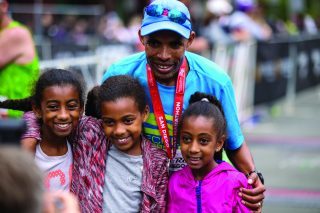
Sometimes, I’m glad I didn’t always listen to my mother. When I’d be tired from running so much at UCLA, she would always say, “No more running. It’s time for an office job.” After I ran my first marathon, my mom said, “No more marathons. It’s too hard on your body.” She was right. Marathons are hard on your body. And if you don’t respect the miles and the course, it will take its toll on you. But I didn’t listen. And I was blessed to go on to have an amazing career, which will come to an official end at the New York City Marathon.
Coming from a big family, I always had the support of my siblings. They encouraged me, they motivated me and they were never shy about saying they were proud. That was always something that helped pushed me.
As the father of three daughters, the importance of family is something I’m trying to convey to them. We are always looking for fun, new ways to bond and connect with them. We try to expose them to outdoor living and the recreational lifestyle. Obviously, running has been a major part of my life, so that has trickled down to my family.
I was fortunate enough during the summer to be able to run the Rock ‘n’ Roll San Diego 5K with my kids and it was a great experience. They don’t train. They just wake up and run. It’s fun for me to see how much they love to run—and not just because of who their dad is.
Running is a family all unto itself. And as the kids head back to school this fall, I’m hopeful our running experiences this summer will be something that they’ll always remember. People often say to find your passion in life and find a way to monetize it. That way you’ll never have to “work” a day in your life. What I’ve done over my career has been work. It’s been hard. And it’s been hard on my body. But it’s also been a passion. As has my family. Never forget that your family should always be your first passion. I’m sure your mother has said that to you.
You should really listen to her more.
RELATED: 5 People Meb Thinks You Should Follow On Twitter
The post What Meb Learned From Time Spent Running With His Family appeared first on Competitor.com.
7 Ways To Support A Significant Other Who Runs

As tough as this can be to imagine, running is not everyone’s favorite sport. This group can include the people closest to us, such as a significant other. Even if your partner has no plans to run a single step, they probably still want to cheer when you do. However, many are not sure of the best way to support us during our training cycles. If you have a partner who wants to champion your running, but doesn’t know how, you can show them this list.
Ask and Listen
Make an effort to check in with your partner on their progress. Do you necessarily understand or care about every split in their 400-meter interval workout or the elevation profile of their long run? Probably not. But asking about their training is quite easy. Showing that you support their goals with this one simple action goes a long way.
Respect Their Schedule
Races start early. Long runs can be tiring. No runner should ask their partner to put their life on hold—that’s unreasonable. But if your significant other wants to turn in early or wake up before dawn, respect that. Don’t prevent a good night’s sleep before a big race by making plans or staying out late. If they are getting their run or race done early, it’s likely so they can spend the rest of the day with you.
Make A Plan
When training for a distance race, long runs and workouts can take up a significant amount of time. Scheduling runs around other life commitments can be difficult, especially if there are kids that need to be cared for. Talking about expectations and priorities before these longer runs really helps to avoid any stress and hard feelings. Most of all, avoid guilting your runner for their time away. Everyone has different ways to better themselves. Some of us just need a 20-miler to do so.
RELATED: The Best Qualities To Look For In An Ideal Running Partner
Have Post-Long Run Food Ready
After running double digit miles, the last thing any runner wants to do is worry about making or finding food. They want it NOW. The best thing a doting significant other can do is have a meal waiting when their runner returns from their long run. Another alternative is to plan for your runner to end at their favorite eatery. Just pack a change of clothes and a towel for them. Even if they can’t eat immediately following a long run, having something like chocolate milk, water, and coffee ready is much appreciated.
Assemble A Pre-Race Gift Basket
This nice gesture also shows that you have paid attention to what they have needed during their training. It doesn’t have to be big to be thoughtful. Include their preferred fuel, an anti-chafe stick, new pairs of their favorite socks, extra safety pins, a hat or sunglasses and sunscreen. Basically think of anything they will need on race day. If you want to go the extra mile (pun intended), make sure they are always stocked with their favorite fuel during their entire training cycle.
Create A Race Day Spectating Plan
Look at the course map well ahead of time to see where you can cheer. The more places you can get to, the better. Inform your runner approximately where you will be so they can look for you. Then make sure you’re at your cheering spot at the right time. Sign up for any tracking updates or make sure you know your SO’s goal time. Bonus points for homemade signs and cowbells.
Don’t Forget To Celebrate
Whether it’s a 5K or a marathon, finishing a goal race is cause for celebration. Make sure you have something planned to after their race. It doesn’t have to be a huge party—although that’s always fun. It could be a scheduled massage or a date. Think of something to celebrate your partner’s hard work and dedication. It can also acknowledge how your support and teamwork helped them along the way.
RELATED: 10 Mental Health Benefits Of Running
The post 7 Ways To Support A Significant Other Who Runs appeared first on Competitor.com.
August 23, 2017
Texan Ranch Transformed Into A Trail Runner’s Playground
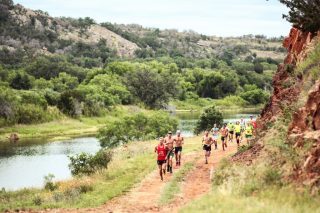
Photo: Courtesy of Rogue Trail Series
“I finally finished. After six months of working from dawn to dusk, we now have 25 miles of canted, soil-managed, mud-free, non-intersecting trail!” exclaims Vol Montgomery, owner of Reveille Peak Ranch in Burnet County, Texas. Montgomery was more tired and relieved than proud, and that says a lot about his modest, determined work ethic.
I met Montgomery on a cold, rainy day in December, when he took a break from his trail work to show me the lay of Reveille Peak Ranch, a 1,300-acre nature and adventure center in the Texas Hill Country of the Highland Lake District, used for outdoor education and training. During weekdays Reveille is often occupied by law enforcement, military, and especially SWAT and Special Ops teams that use the rugged, remote and diverse terrain for a wide variety of training. It even has SCUBA diving facilities.The day I was at the ranch, there was a group leaving the base compound for long-range rifle practice instructed by a Navy Seal trainer.
Reveille Peak Ranch still serves as an active cattle ranch. However, Montgomery supplements that with training on weekdays, and on weekends the ranch becomes a playground for running, mountain biking, obstacle course and multisport events. “It is a versatile piece of land and I use to its fullest capacity,” Montgomery explains.
Montgomery has strong ties to the Texas service community, given that he’s a sixth generation Texan and a member of the “Sons of the Republic of Texas.” Texas Rangers run so deep in his family that they pre-date Texas’ statehood.
“I know we go back before 1836, but I haven’t done a lot of the research before that point,” said Montgomery. After graduating from Texas A&M University, Montgomery started a network integration company in Austin. In only six years the company had grown so much it became an Inc. 500 award recipient for— fastest-growing privately-held company in the U.S. Montgomery’s company was acquired in 1999 and he retired from the tech industry a couple years later.
Montgomery then threw his enthusiasm into making Reveille Peak Ranch what it is today—converting it into a race destination extraordinaire for trail runs, ultras, mountain bike races, multi-sport events and Spartan racing. He set up a permanent obstacle course on the property and did such a fine job with the course that Montgomery was asked to duplicate it for Camp Gladiator in Austin and a SWAT team that wants one as well. He builds the obstacles out of used drilling pipe, which has a great patina of rust to give needed grip and traction.
Reveille Peak Ranch also features a big cook-house, covered pavilion and plenty of elegant rustic space for post-race celebrations. One of the most scenic parts of Reveille Peak Ranch is called “Decision Point,” a rocky vista where Montgomery married his wife. And just down the road from Reveille Peak Ranch sits Canyon of the Eagles, a 940-acre park, offering a spider web of winding running trails, camp-like accommodations, and an excellent restaurant.
Now that there are 25 miles of continuous trail—Montgomery is going to use a survey team to make sure the measurement is precise because he doesn’t trust the accuracy of GPS and barometric pressure readings—Reveille Peak Ranch is poised for more and bigger races. There is a mile worth of climbing within the 25 miles, and the trail is almost never flat. Montgomery’s long-time friend, Paul Carrozza, former owner of RunTex stores and track coach of Austin’s prestigious St. Stephen’s Episcopal High School, recommended that a good portion of the Reveille Peak Ranch trails be wide and smooth so that Austin runners used to the Town Lake , now called “Lady Bird,” would be able to adapt to the hills of Burnet County. Montgomery took his friend’s advice, but somewhat tongue-in-cheek, has named the hilly section of the 25-mile trail “Carrozza Boulevard.”
Reveille Peak Ranch also plays host to Austin’s Rogue Running’s Captain Karl’s Night Trail Race, Pandora’s Box of Rox, and some obstacle course races, in addition to mountain bike races and “A Girl & A Gun” national training conference. Montgomery hopes to make the trail the first IMBA-certified park in Texas with flow trails, shuttle assist gravity terrain and a four-lap 100-mile course that would be a Leadville 100 qualifier.
RELATED: 5 Places To Run In Dallas
The post Texan Ranch Transformed Into A Trail Runner’s Playground appeared first on Competitor.com.
Ryan Hall's Blog
- Ryan Hall's profile
- 21 followers



